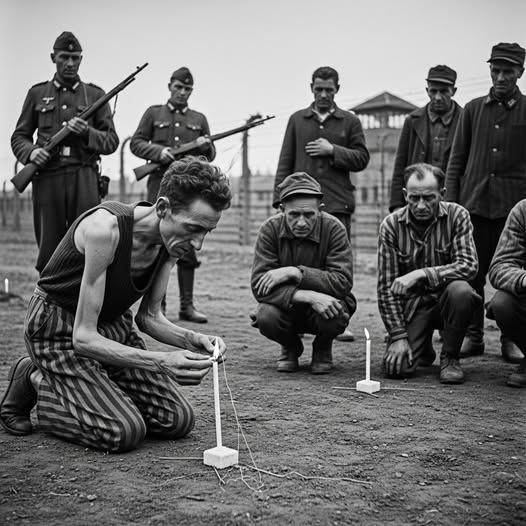Soap candle – Mauthausen, May 1945
In the spring of 1945, the silence over Mauthausen was no ordinary silence. It was a burden that neither the hills of Upper Austria nor those who emerged from behind the camp barbed wire could bear, alive but broken. Liberation, which arrived in May, was not merely a moment of triumph. It was a moment suspended between death and life, between shadow and light, between memory and oblivion. What happened then remained in the hearts of the survivors forever, but only a few were able to express it later.
The Mauthausen concentration camp, one of the most brutal in the entire Nazi terror machine, became a place where people lost not only their lives but also their names, their dignity, and their hope. In the musty barracks, in the quarries where prisoners perished under the weight of stones, and in the rows of executions whose rhythm dictated each day—there, humanity was suppressed until its last breath. And yet, as the May sun of 1945 spilled its pale light over the barbed wire and American soldiers entered the camp, one flame remained, refusing to be extinguished.
At Mauthausen, soap was never a symbol of hygiene or freshness. It was ironically distributed to prisoners as a reminder of normalcy, but in reality, it only served to exacerbate the absurdity of life in the shadow of the crematoria. Bars of hard, coarse soap, whose scent never washed away the grime of camp life, became silent witnesses to suffering.
When the camp was liberated, some survivors stumbled upon remnants of these objects—scattered, useless, resembling more shards of a bygone nightmare than anything practical. Among them was a prisoner whose name remained unaccounted for. He was known only as “the one who made the candle.” He was emaciated, his body trembling like a branch in the wind, and his eyes—sunken, dark—stared into space, as if trying to find the faces of long-lost loved ones.
It was he who grabbed the piece of soap, turning it over and over in his hands as if searching for an answer. Perhaps it was then that he realized that what was meant to be a sign of degradation could still be transformed into a symbol of remembrance.
Melting soap in primitive conditions seemed absurd, yet the survivor found a way. In an old vessel, amidst the ruined barracks, he slowly melted it, drop by drop. The other prisoners watched silently, not yet grasping the meaning of his gesture. Then, when the waxy mass had hardened, he shaped it into a small candle. One handed him a piece of string, another brought a metal rod to make a hole for the wick. It was painstaking work, but there was a ceremony behind it, as if every movement of the hand were a prayer.
When the candle was ready, the prisoner knelt and lit it. The flame was weak, flickering, dancing in the wind, but in its fragility lay its strength. A group of survivors gathered around. They watched in silence, a silence deeper than screams, stronger than words. Light reflected in their eyes, and in that glow, the faces of those who were no longer there were also reflected.
“For those who cannot see this day,” the prisoner whispered, his voice trembling like a flame.
At that moment, soap ceased to be an object of shame. It became a sacred symbol. The candle was fragile, capable of extinguishing at any moment, but its light was more powerful than the crematorium fire.
The liberation of Mauthausen in May 1945 brought freedom to the survivors, but also a burden. Many never regained their health or their families. They returned to countries that sometimes refused to listen to them, where survivors’ testimonies were treated as an uncomfortable shadow of the past. Yet those who witnessed the lighting of the soap candle never forgot that moment.
One of them, a Pole from Krakow, wrote years later:
“We were surrounded by death, and yet that small flame taught me that life always finds a way to speak. It wasn’t a candle. It was a soul.”
Such testimonies have become the foundation of Holocaust remembrance. Thanks to them, the modern world knows not only numbers and facts but also stories filled with pain and hope.
The soap candle became an unofficial symbol, passed down orally. It’s not found in military reports or administrative archives. It’s a whispered story, told to surviving children and grandchildren, a story that eludes documents but lingers in the memories of the living.
Today, when we speak of the liberation of concentration camps, we often evoke images of American soldiers distributing bread, photographs of emaciated prisoners, and documentaries made by the Allies. But there, in the shadow of these grand images, small stories also remain – like the one about the soap candle. Stories that teach us that the gesture of remembrance can be more powerful than an entire empire built on forgetting.
Today, visiting the Mauthausen memorial, we see stone walls, restored barracks, and exhibitions filled with photographs and documents. But the true lesson of history lies in those moments uncaptured by cameras. In the gesture of the man who fashioned a candle from soap. In the gazes of prisoners who silently gazed at the flame, seeing in it the reflection of those who never returned.
It is this story that makes remembering the Holocaust so important. It is not just a story of death and cruelty. It is also a story of strength of spirit, of restored human dignity, and of hope that refused to be extinguished.
The light of this candle—though fragile and fleeting—illumines the darkness of history to this day. It serves as a warning that even in the deepest shadows, a spark of humanity can be found.
Note: Some content was generated using AI tools (ChatGPT) and edited by the author for creativity and suitability for historical illustration purposes.



Leave a Reply